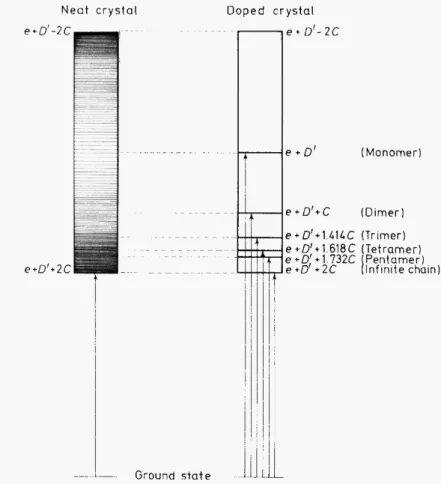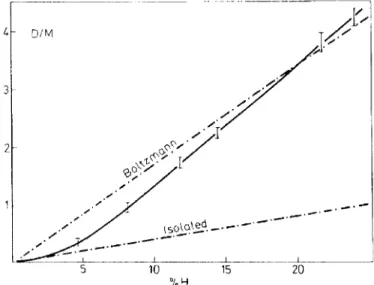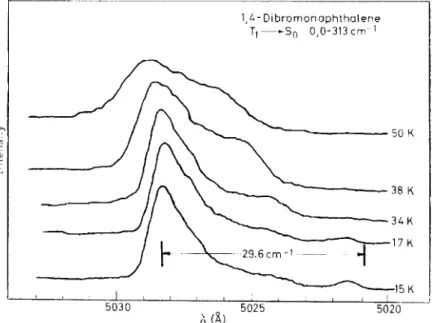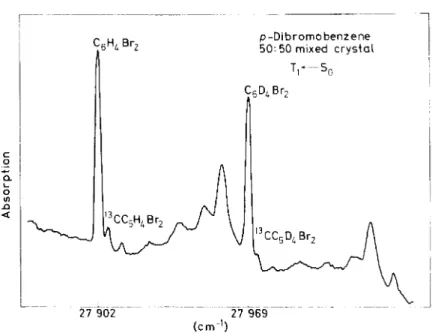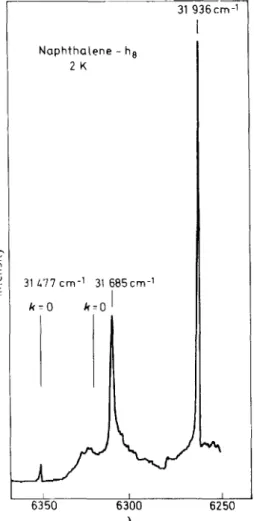EXPERIMENTAL STUDIES OF TRIPLET EXCITON BANDS OF MOLECULAR CRYSTALSt
R. M. HocHSTRASSERt. T.-Y. L1, H.-N. SuNG. J. WESSEL and A. H. ZEWAIL
Department of Chemistry and Labaratory for Research on the Structure of Matter, Universily
of
Penmyluania. Philadelphia. Pennsylvania 19174. USAABSTRACT
Methods of studying propcrties of triplet exciton states of organic crystals are presented with an cmphasis on exposing the rlimensionality of excitons.
Results ofisotopic replacement spcctra for 1,4-dibromonaphthalene which is a linear chain, anrl for halogenaterl benzenes, which are likely tobe linear chains, are presented. Luminescence sturlies oflinear chain exciton systems are shown to yiclrl information about the stationary states of small clusters. Finally some prcliminary sturlies of two-photon spectra of naphthaJene excitons are
rlescriberl.
Experiments have now established a number of characteristic propcrtics for triolet excitons in organic crystals.
(i) Triplet exciton bandwidths are often small in the range ca. 0 to 40 cm -t.
An exception appears to be diiodobenzene1 where the band maybe ca.
103 cm-1• Since all cases studied except diiodobenzene are clearly in the weak coupling2limit, we use the term bandwidth with reference to a particular vibronic state---often the zero-point Ievel of the triplet state. The bandwidth is not exposed by observing a factor group splitting since the translationally equivalcnt interactions may dominate.
(ii) The theoretical prediction3 that short-range resonance force inter- actions should determine the band structure of triplct excitons is cxperi- mentally verified for the case of dibromonaphthalene4. The implication is that the energy transfer topology depends on intermolecular overlap and that there is a possibility of predicting band structure and energy transfer anisotropy from crystal structure.
(iii) The phonon sidebands associated with singlet triplet transitions in crystals are often strong and may even be stronger than the zero phonon lines.
This condition arises when the bandwidths are very small5 since there may then be many lattice motions during the jump time ofthe electronic excitation.
One of the most interesting aspects of triplet excitations in molecular cry- stals concerns the relationships between the energy transfer topology-the
t This researchwas supported in part by the NSF-MRL contract No. GH-33633. in part by a Public Health Grant GM 12592, and in pa~ by an NSF grant.
t Presenter of paper at Tallinn
85
R. M. HOCHSTRASSER, T.-Y. LL H.-N. SUNG. J. WESSEL AND A. H. ZEWAIL
effective dimensionality of the exciton-and the chemical and crystal struc- ture of the system. Expcrience with anthracene6 and naphthalene7 showed that approximate numerical calculations3 were not reliable in predicting details of band structure. and a real need for experiments on a wider dass of molecules became apparent. Our starting point was a study of crystals that display no Davydov splitting of their singlet~triplet transition. Excitons in such systems may have either a simple dispersion similar tothat in a crystal having one molecule per unit celL or each of the resonance interactions must be much smaller than the opticalline width. ln the simplest three dimensional case the dispersion will bc given by:
s,. = :L2V,cos(r.k) (1)
where V, is the nearest neighbour resommce force interaction. For the dis- persion (equation 1) to occur in a real crystal the interactions between mole- cules in the different translational stacks (labe IIed by :x) must be negligible:
this is a feature of the restricted Frenkel limit8. We have shown4· Y that 1. 4-dibromonaphthalene (DBN) is a linear chain with J-;, ~ ~·~ ~ 0 and
Table 1. Structural data for some halogcnated aromatics.
a (,\) b (Ä)
- - - -
(l-p-dichlorobenzenet 14.63 5.66
p-dibromobenzenet 15.36 5.75
sym-trichlorobenzene~ 13.77 13.07 sym-tribromobenzene9 1393 13.19 s ym-tctrachlorobenzenell 9.60 10.59 ß-sym-tetrabromobcnzcnc •· 10.32 10.71 hexachlorobenzenett 8.08 3.H7
t E. Frassun. C Ga.tbuglio and S. Bevi Acta Crvsf.. 12. 126 (l ~5Y)
! S Bezzi and U. Croatla. Guzz. Chim. Jtal .. 72. j,l H ( JIJ42).
~ H. J Milledge and L. M. Paut. Acta Crvsr.. 13. 2X5 I Jq6f))
!I F H. Herbsteln. Acta Cr_nt.. 18. 997 ( 19651.
• (i. Ga.ftler and F H. Hcrbstein. Aelu Crnt.. 13, 706 (196()) I ;\1, Strel'tsova and Y T Struchkov. J Struct Chem .. 2. 2lifl119111)
c (ÄI ll\9 4.10 3.83 3.91 176 4.02 16.65
z 2 2 4 4 2 2 2
113.3 112.5 90 90 102 ~ (92.51 102.3 117.0
V., = 7.4
±
0.4 cm-1 for the 0.0-lcvel of the first triplet state. A number of similar systems studied in this Iabaratory are shown in Tah/e I and it is seen that thc crystals of halogcnatcd aromatics havc the common feature of one very short intermolecular contact It is reasonable to guess that they are all essentially linear chain exciton systems and the first part of this paper will be a summary of optical cxpcriments designed to expose the exciton band structures of some of these materials.1 ,4-Dibromonaphthalene
Whiteman's experiments4 can be understood from the schcmc shown in Figure I. When the crystal is neat. optical transitions occur only to the k = 0 Ievel of the band at 20 192 cm-1• On adding the fully deuterated iso- topic impurity, linear cluster states are created and discrete spectra are now observed throughout the whole exciton band. These spectra can be fitted to
TRIPLET EXCITON BANDS OF MOLECULAR CRYST ALS
theoretical formulae for duster energies and statistical distributions, each formula involving a nearest neighbour resonance interaction parameter
(~in this case). Wehave observed duster states containing up to six molecules
Neat crystal e +01 -2C
Ground state
Doped crystal ,.---...., e + 01- 2C
-1 - r - - - - l e + 0'
t
(Monomer)(Dimer) 1-H-r---ie + 01 + 1.414 C (Trimer)
t e + 01 + 1.618C (Tetramer)
""t
e +O' +1.732C (Pentamer)! i e + 01 + 2 C (I n finite c ha in l
I I
I I
•
II
, II
~t
l1~
Figure 1. Schematic diagram of expected spectra of a heavily doped inverted linear chain band.
Only the strongest transitions are depicted
and therefore wc have six independent measurements of ~- Each duster state gave the same result for ~ within the error quoted above so this study provides a confirmation of the nearest neighbour approximation, as weil as establishing the linear chain nature ofthe band and the sign ofthe interaction parameter. The latter condusion and our intuition regarding the c direction was later confirmed by means of the exciton diffusion sturlies by Ern 1 0 that show Dc tobe much larger than Da or Db. Recently, optically detected e.p.r.
sturlies have been used to estimate the much smaller interstack resonance interaction 1 2•
LUMINESCENCE PROPERTIES OF LINEAR CHAIN SYSTEMS The luminescence of DBN neat crystal consists of transitions originating at many traps and of exciton emission. The lifetime 12 of the exciton emission
R. M HOCHSTRASSER, T.-Y. LI, H-N. SUNG, J WESSEL AND A. H ZEWAIL
is about 0.5 ms at 1.6 K. The effective dimensionality of the excitations in this crystal is dramatically evidenced by the nearly I 00-fold increase in phosphorescence that arises when the protocrystal is doped with perdeutero molecules4. The Juminescence of the mixed crystal comes from a variety of duster states and the results give new information on the nature of energy transfer between clusters in these crystals.
0/M
3
2·
-·-· -·-
\so\oted.-.-·- - · - · - ·
-·-·-·-·-·-·-·-
iI .___j
10 15 20
%H
Figure 2. Variation with dibromonaphthalenc (DBN)-h6 in DBN-d., concentration of the ratio of dimer (D) to monomer (M) emission intensity at the 0. 0-transition. The temperature is
4.2 K.
In recent work by ZewaiJI3 it was observed that at 4.2 K the Boltzmann distribution over the monomer and dimer statcs is only achicvcd whcn thc concentration of DBN-h6 in DBN-d6 exceeded about 10 mole per cent.
Preliminary results at low spectral resolution are shown in Figure 2 and their probable interpretation involves the sensitivity ofthe trap-to-trap migration 14 of excitation to the distance between these duster states. lf the thermalizing mechanism in the mixed crystal involved only the intrachain intcractions and if during the lifetime of the trapped excitation (r ~ 4 ms) the number of different clusters visited (N) is determined by a one-dimensional random walk proccss, then:
(2) where n is the average number of host molecules betwecn clusters and 1\E is the deuteration shift of 65 cm- 1• In the case of DBN we havc ( ~//\1:') ~
0.1 so N is of order unity (i.e. thc cxeitation remains on a few clusters) when n ~ 8. At concentrations of guests for which n = 4 already N = 300. Bccause of the mismatch in the monomer and dimer energy Ievels the intrachain trap-to-trap migration is slowed down so it is likely that interchain coupling participates in the thermalization mechanism. For n = 4 the trap interaction
TRIPLET EXCITON BANDS Of' MOLECULAR CRYSTALS
energy is ~
v;
+ 1I
!1E' which is about 7 x 1 0-4 cm-1 and we may expect the interchain interaction to exceed this.Since DBN molecules have no centre of inversion the two molecules A and Bin the translationally equivalent dimerarenot equivalent so the wave function for the lower energy (emitting) dimer state in first-order must be written:
(3) where rp and rp' are Born Oppenheimer states for different electronic excita- tion. We can tell that the excitation is close to being equally distributed over both molecules in the dimer from three observations. Firstly. the heavy doping experiments and computations of V.: from these are self-consistent4. Zcwail13 has shown that the ratio of dimer to monomer emission is roughly twice as !arge for the 0,0-transition as for emission on to vibrational Ievels of the ground state. This implies that C 1 ~ C 2 ~. 1
I J2
if the vibrational excitation is shared between the two molecules. The third observation that pertains to this question of delocalization of the excitation is the optically detected magnetic resonance of DBN monomers and dimers recently studied by Zewail13 in which averaging of ground and excited state coupling con- stants is observed in the dimer spectrum.BAND-TO-BAND TRANSITIONS
Assuming that excitons thermalize in band states having definite k vectors the luminescence from the neat crystal zero-point Ievel band into bands corresponding to ground state vibrationallcvels should have the line shapes depicted in Figure 3 for various tcmperatures. These theoretical line shapes assume a vanishingly narrow vibrational exciton band and the line shape function is simply:
g(w)pk(w) e-"'kikT (4)
where g(w) is a Lorenzian. pdm) is the density of k states at Oh = cklh. Since we know the density of states in this case luminescencc band-to-band experiments can be used to study the influence of exciton-phonon interactions on the radiative properties of molecular crystals. Li14 has studied band-to- band transitions in DBN and a typical result is shown in Figure 4. We find the expected double humped emission line shape-the separation between the humps is somewhat less than 4 ~ -proving that the excitons are really thermalized into definite k states at these temperatures. Also the opticalline shape for the zero-zero transition to the k = 0 region ofthe band is less than the exciton bandwidth indicating that the exciton-phonon scattering is not
!arge enough to cause Iocalization of the excitations. Nevertheless there seems to be an efTect due to the finite width of the vibrational exciton bands of the ground state.
EXCITON-PHONON COUPUNG
In considering exciton-phonon coupling in pseudo linear chain systems it is necessary to consider that the efTective phonons may not be those of the
89
R. M. HOCHSTRASSER. T.-Y. LL H.-N. SUNG. J. WESSEL AND A. H. ZEWAIL chain and the optical phonans of the real crystal may play a part Indeed temperature effects (Figure 4) on band-to-band transition may indicate
Figure 3. Calculatcd band (T 1) to band (vibrational) transition for linear chain
that population of phonon bands, other than a smoothly varying linear chain acoustic band, is occurring. The whole question of exciton-phonon coupling and its influence on exciton spectra and dynamics in molecular crystals is not yet fully explored. For example the absorption spectrum of DBN at low temperatures shows essentially no phonon sidebands, and we have proposed that this is because the exciton stabilization comes mamly lrom the transfer of excitation energy in this cases Rut this is not always so cvcn in rather similar crystals. sincc in the case of dibromobenzenc it appcars as if the stabilization energy arises by an excited molecule changing its position in the lattice. The rcsult is that intense phonon sidebands are sccn in thc absorption spcctra just as if the excitations wcrc small polarons'. In thesc crystals it is possible that the halogen halogen forccs (attractivc'') detcrminc the nature of the stacking of molcculcs. this would account for thc 4uitc similar contacts found in a variety of halogenated benzene crystals. Thc differences in exciton phonon coupling would derivc from variations in thc
TRIPLET EXCITON BANDS OF MOLECULAR CRYSTALS
distance dependence of the van der Waals forces and it is not apparent why there should be other than small diffcrences in a scries of isomorphaus (or 'nearly' isomorphous) structures. Again the interchain phonons have to be considered and so it is probably not justifiable to draw conclusions from the comparison of different structures (DBN and DBB) even though the c-chains have similar halogen contacts and interplanar separations .
>, Vl
<::
'"
c
... -·--~---~~---~,
I, 4- Dibromonaphthalene
T1---~s0 0,0-313 cm-I
50 K
38 K 34 K
Figure 4. Emission of DBN-h6 at various temperatures in the region of the band-to-band energy corrcsponding to a 313 cm-1 mode of the ground state_ The vertical bars indicatc the cxpcdetl extremes bascd on the upper state being a linear chain of bandwidth 29.6 crn-1. Rcccnl
work by Zewail13 indicates that the actual bandwidth is close to 25 cm-1
BAND-STRUCTURE AND CARBON-13 TRANSITIONS Most of the halogenated benzene crystal spectra that have been studied show in addition to a strong sharp zero-phonon transition at least two additional weaker lines at ca. 4-6 cm -1 and ca. 7 11 cm - I from the zero- phonon line. Thesetransitions were first observed by Castro16 but no inter- pretation was placcd on them at that time. We later realized that they wcre most probably due to 13C isotopic impurities9 in natural abundance. The six carbons of p-dichloro, p-dibromo and sym-tetrachloro-benzcne (for example) group into two inequivalent sets containing four and two carbons.
This grouping may account for the two weak lines seen in the singlet-triplet absorption spectra, and on that assumption it is possiblc to ust: these tran- sitions to leam about details of the exciton band that may otherwise have been too minute to detect using optical spectroscopy.
For a zero-order trap depth of eS, measured from the centre of the host exciton band, the trap energy E for a linear chain is 17 • 18
E =
± [
4 V~+ ( ±
)c52J1:
91
(5)
R. M. HOCHSTRASSER. T.-Y. LI. H.-N. SUNG. J. WESSEL AND A. H. ZEWAIL
where the plus sign is used when () is positive. The obscrved isotope transition always lies outside the band (i.e. E >
12
Vc J) and the intcnsity of transitions to the isotopic impurity is enhanced or diminished by the factor 19:(6) It should be noted that the observed energy differencc -1E; between the as- sumed isotopic impurity line and the zero-phonon line of the host (k = 0) is not equal to E. but is given by .·
-1<:; = E - 2V.. (7)
Thus a simple energy measurement in the neat and. say. chemically mixed crystal can measure 2V,. foralinear chain. A plot ofthc quantity in equation 6 for .1F.i values of 5.2 cm-1 and 7.5 cm-1 is shown in Fiyure 5 and it can be seen that extremely narrow bandwidths can cause readily measurable effects on the 1 3C transitions. As we learned many years ago (I herewith acknowledge helpful discussions with Professor T. M. Dunn during 1968 regarding the spectra of p-dichloro- and p-dibromobenzene) a high resolution spectrometer
' l
-c mtenstty compnred wtth tha! 1n natural abundunce
30
V>O 20 .
a.
= 52 cm 1'--_L__=-':c-· .. L __ . . . .I.. ___ L_L __ J _ _j_ _____ .J _ ___L
'J 0 10 0
Lmear chatn bandwtdth (~ß) (cm-1)
Fiqure 5. Theoretical relative intensity changes expectcd for shallow traps in a linear chain band
92
TRIPLET EXCITON BANDS OF MOLECULAR CRYSTALS
must be used to measure the relative intensities of the zero-phonon lines since they may be exceedingly sharp- and our early intensity data 1 7 were soon found to be unreliable because of a spectrometer Iimitation 19 . In the absence of site shifts the shift between a neat crystal transition and that tran- sition in a dilute mixed crystal (proto in deutero) is equal to 2 V,. for a linear chain. For example in the case of tetrachlorobenzene the 0.0-transition for thc ncat crystal coincidcs ( ±0.2 cm-1) with the dilute h2 in d2 origin indi- cating that if the system is a linear chain 2 V,. is less than 0.2 cm-1• assuming that the site shift is ncgligible. The 13C-band intcnsitics are difficult to assess accurately for tetrachlorobenzene because the crystals are twinned triclinic and additional lines appear in the absorption spectrum near to the origin bands. The assumed 13C transitions for tetrachlorobenzene molecules isolated in a dilute mixed crystal of durene appear at 5.5
±
0.2 cm-1 (weaker) and 7.7 ± 0.2 cm -1 (stronger x 2) to higher energy than the 12C zcro--zcro transition. The intervals in the neat crystal are 5.7±
OJ cm-1 and 7.6±
0.3 cm - t with the .former the stronger. If these pairs of Ievels are assumed to be the 1 3C transitions in both neat and chemically mixed crystals, and if it is assumed that the site shifts for (13C-CI)C5H 2Cl3 and (13CH)C5HC14 are the same a<> for C6H 2Cl4 • then using equations 5 and 7 the bandwidth must satisfy the inequality:
0 < 4v~ < 0.8 cm-1 in agreement with isotopically mixed crystal results.
HEA VY DOPING AS BAND-STRUCTURE INDICATOR For one-dimensional and some two-dimensional bands the effects of energetically distant deutero molccules on thc spectrum of thc proto crystal is such that the band structure and therefore the exciton dimensionality can be exposed by doping experiments such as those used for DBN4 and pyri- midine12. Heavy doping is also useful for exposing narrow exciton bands.
The quantity measured in a heavy doping experiment is the spectral density20 for k = 0 and for systems having simple dimensionality this distribution is wide enough for about one-half of the band to be exposed by conventional optical absorption sturlies (for example, see the DBN spectra from Ref. 4).
In the case of the halogenated benzenes that display the 13C transitions dis- cussed above the effect of heavy doping is rather slight. Figure 6 shows the absorption spectrum of a 50 per cent mixed p-dibromobcnzene-h4 and d4
crystal in the region of the zero-zero band. The asymmetric line broadening ofthe zero-phonon transitions is less than ca. 0.5 cm-1 implying a linear chain bandwidth ofless than 1 cm- 1 : the absence of Davydov splitting ( < 0.5 cm-1)
indicates that the interchange equivalent Interaction is less than 0.5/8 cm-1.
Tetrachlorobenzene shows no asymmetric line broadening on heavy doping (see Figure 7), but there is a small (ca. 0.5 cm -1) symmetric line broadening. In this case the line width ofthc ncat crystal transition is 2.0 cm - 1 so if the system is a linear chain exciton the bandwidth is indicated to be less than ca. 2 cm -1, consistent with the mixed crystal energies discussed above, and with approximate values for the energies of the 13C transitions based on a
93
R. M. HOCHSTRASSER. T.-Y. LI, H.-N. SUNG, J. WESSEL AND A. H. ZEWAIL
(:
-
0 a. 1...0 1/l ..Cl
<{
_______ j_ ______ _
27 902
- - - -
p-Dibromobenzene 50:50 mixed crysial
_ ___ L ___ ---
27 969 (cm-1)
T1·--50
Figure 6. Absorption spectrum of a 50:50 mixed crystal of p-dibromobenzene-h4 and d4 . Note the Iack of line broadening and the similarity of 13C transitions in the h4 and d4 spectra
(J\
t
c c
<11 -"' u 0
::0
<11 0 ()._
Tet rachlorobenzene T1•-S0
______ L_ __
26 660 Figure 7. Heavy doping with tetrachlorobenzene-d2 of TCB-h2 . Note the symmetric line
broadening
TRIPLET EXCITON BANDS OF MOLECULAR CRYSTALS
linear chain exciton with k = 0 at the top of the band as suggested by the experiments of Francis and Harris21. Tbe bandwidth suggested by the optical experiments is narrower than that deduced by Harris. However we cannot teil whether or not tetrachlorobenzcne is a linear cbain; we can only put restric- tions on the bandwidth of tbe exciton based on assumptions regarding its topology.
TWO-PHOTON SPECTROSCOPY AND EXCITONS
In concluding this discussion of triplet excitons I wish to mention a spectroscopic technique that Sung and Wessei have recently used to study
>.
+--
"'
c
Q)
c
Nophthalene- h8 2 K
31477 cm-1 31 685cm-1
k~o k~ol
6350 6300
.\
31 936 cm-1
I
6250
Figure 8. Two-photon unpolarized excitation spectrum of naphthaJene in the neighbourhood of the 0, 0-band of the first singlet state. The vertical bars mark the positions of the k = 0 exciton
Ievels known from one-photon spectra
95
R. M. HOCHSTRASSER, T.-Y. LL H.·N. SUNG, J. WESSEL AND A. H. ZEWAIL
singlet excitons, and which can be adapted to study triplets. The technique is high-resolution two-photon excitation spectroscopy22 and involves scanning in the region of one-halfthe exciton energy with a tunable dye Iaser.
A small portion of the spectrum of a single crystal of naphthaJene at 1 .6 K is shown in Fiyure R. The spectrum refers to thc origin region of the first excited singlet state of the naphthaJene crysta\23 The bars marked k = 0 refer to the positions of the k = 0 transitions in one-photon spectroscopy.
The 31 685 cm-1 band is not seen in the one-photon spectrum. Two aspects of these spectra are pertinent in the present context : the presence of the 31 685 cm-1 line. which presumably has g parity. so close to the cxciton band edge emphasizes the incompleteness of one-photon optical studies hased on only u parity Ievels: the presence of u parity k
=
0 transitions that have essentially the same appearance as they have in the one-photon spectrum24 is quite a new phenomenon. We suggest that the k = 0 transitions occur be- cause of the simultaneaus absorption of two photons, one via an electric quadrupole/magnetic dipole mechanism. The probability amplitude for such a process is low enough that we believe two-photon absorption studies of singlet-triplet transitions and oftriplet excitons are now also within rcach.HEFERENCES
1 G. Castro and R. M. Hochstrasscr, M nl. Crysl., 1. 139 (1966).
2 W. T. Simpson and D. L. Petersen, J. Chem. Phys .. 26. 588 ( 1957).
3 J. Jorlner, S. A. Rice. J. L. Katz and S. I. Choi, J. Chem. Phvs .. 42. 309 (1965).
• R. M. Hochstrasscr and J. D. Whiteman, J. Chem. Phys .. s6. 'i945 (1972).
' R. M. Hochstrasserand P. Prasad. J. Chem. Phys., 56.2814 (1972).
" R. H. Clarke and R. M. Hochstrasser, J. Chem. Phys. 46. 4532 ( 1967).
7 R. H. Clarke and R. M. Hochstrasser. J. Chem. Phys., 49, 3313 ( 1968).
8 G. W. Robinson, Ann. Re11. Phys. Chem., 21.429 (1970).
" R. M. Hochstrasser and J. W. Whiteman. (a) 24th Symposium on Molecular Structure and Spectroscopy, Abstract 1.11, Columbus, Ohio (1969): (b) Organic Scintillators muJ Uquid Scintillation Counting. p.511. (ed. D. L. Horrocks and C.-T. Peng), Academic Press. New York (1971), (proceedings of a conference in San Francisco, July 1970): (c) 26th Symposium on Molecu1ar Structure and Spectroscopy, Abstract U1, Columbus, Ohio (1971).
10 V. Ern, J. Chem. Plzys .• 56.6259 (1972).
11 R. Schmidberger and H. C. Wolf, Chem. Phys. lRtter.1, 16.402 (1972).
11 J. D. Whiteman. PhD Dissertation, Univcrsity of Pennsylvania 11971).
" R. M. Hochstrasserand A. H. Zewail. J. Chem. Phys., in press
14 II. Sternlichl. G. C. Nieman and G. W. Robinson, J. Chem. Phys. 38, 1326 (1963).
1' R. M. Hochstrasserand T."Y. Li, tobe puhlished.
1" G. Castro and R. M. Hochstrasser. J. Chem. Phys .. 46,3617 (1967).
17 G. F. Kosterand J. C. Slater, Phys. Rev., 95, 1167 (1954).
'" D. P. Craig and M R. Phillpoll, Proc. Rny. Soc. (l.fmdun). A293, 213 (1966).
1" See Ref. 5, footnute 32.
2'' P. Soven, Phys. Rev .. 178. 1136 (1969).
'1
C. B. Harris, proceedings of this conference, this volume, p. 73; see also A. H. Francis and C. B. Harris, Chem. Phys.LRtters, 9, 181 (1971).
" R. M. Hochstrasser, H.-N. Sung and J. Wessel, J. ehern. Phys., 58,4694 (1973).
23 R. M. Hochstrasser, H.-N. Sung and J. Wessel, Chem. Phys. Letters, 24. lfiR ()974).
24 See for example, S. D. Colson, D. M. Hanson, R. Kopelman and G. W. Robinson, J. Chem.
Phys., 48, 2215 (1968).

